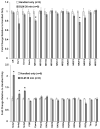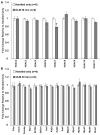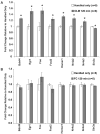Object-location training elicits an overlapping but temporally distinct transcriptional profile from contextual fear conditioning
- PMID: 25242102
- PMCID: PMC4262591
- DOI: 10.1016/j.nlm.2014.09.002
Object-location training elicits an overlapping but temporally distinct transcriptional profile from contextual fear conditioning
Abstract
Hippocampus-dependent learning is known to induce changes in gene expression, but information on gene expression differences between different learning paradigms that require the hippocampus is limited. The bulk of studies investigating RNA expression after learning use the contextual fear conditioning task, which couples a novel environment with a footshock. Although contextual fear conditioning has been useful in discovering gene targets, gene expression after spatial memory tasks has received less attention. In this study, we used the object-location memory task and studied gene expression at two time points after learning in a high-throughput manner using a microfluidic qPCR approach. We found that expression of the classic immediate-early genes changes after object-location training in a fashion similar to that observed after contextual fear conditioning. However, the temporal dynamics of gene expression are different between the two tasks, with object-location memory producing gene expression changes that last at least 2 hours. Our findings indicate that different training paradigms may give rise to distinct temporal dynamics of gene expression after learning.
Keywords: Fear conditioning; Hippocampus; Object-location memory; Spatial memory; Transcription.
Copyright © 2014 Elsevier Inc. All rights reserved.
Figures





References
-
- Abel T, Lattal KM. Molecular mechanisms of memory acquisition, consolidation and retrieval. Curr Opin Neurobiol. 2001;11:180–187. - PubMed
-
- Agis-Balboa RC, Pavelka Z, Kerimoglu C, Fischer A. Loss of HDAC5 impairs memory function: implications for Alzheimer's disease. Journal of Alzheimer's disease : JAD. 2013;33:35–44. - PubMed
-
- Agranoff BW, Davis RE, Casola L, Lim R. Actinomycin D blocks formation of memory of shock-avoidance in goldfish. Science. 1967;158:1600–1601. - PubMed
-
- Alarcon JM, Malleret G, Touzani K, Vronskaya S, Ishii S, Kandel ER, Barco A. Chromatin acetylation, memory, and LTP are impaired in CBP+/− mice: a model for the cognitive deficit in Rubinstein-Taybi syndrome and its amelioration. Neuron. 2004;42:947–959. - PubMed
Publication types
MeSH terms
Substances
Grants and funding
LinkOut - more resources
Full Text Sources
Other Literature Sources
Medical
